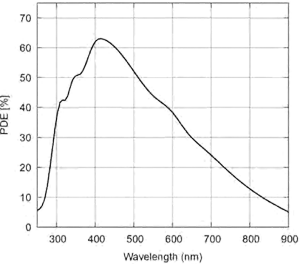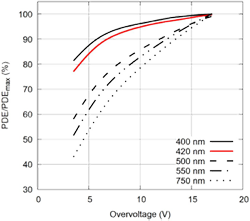Broadcom's SiPM data sheets detail key performance parameters of their SiPMs including the Photon Detection Efficiency (PDE) which is explained in more detail below.
Since the SPADs which make up the SiPM comprise a micro-APD together with the quenching resistor, the interconnecting circuitry and the trenches between the microcells it can be seen that the Quantum Efficiency (QE) of the micro-APD itself is only one aspect of the ability of the SiPM to detect photons. The equation for PDE is shown below:-
| PDE(λ, V) = QE (λ) • PTrigger (V) • ε | ||||
|
QE = Quantum Efficiency - efficiency of conversion process of a photon into an electron-hole pair in the active region of the SPAD PTrigger = Geiger Efficiency - probability that the generated electron-hole pair triggers a Geiger breakdown in the SPAD ε = Geometric Efficiency - ratio of total active region of the SPADs and SiPM "active area" λ = Wavelength V = Voltage |
Note that whilst the Geometric Efficiency (ε) of the SPAD is fixed by the design, Quantum Efficiency (QE) is wavelength-related due to the absorption characteristics of silicon and Geiger Efficiency (ε) increases with Voltage.
Hence the PDE of SiPMs depends on two parameters, the applied Overbias (voltage above breakdown) and the wavelength of the incoming photon - as a result PDE curves for SiPMs are shown with the applied Overbias.
 The large 40µm SPAD pitch and efficient design of NUV-MT SiPMs produces a high geometric fill factor of micro-APD active area (ε). In combination with high QE this produces SiPMs with industry leading PDE of 63% (12V overbias) at 420nm:-
The large 40µm SPAD pitch and efficient design of NUV-MT SiPMs produces a high geometric fill factor of micro-APD active area (ε). In combination with high QE this produces SiPMs with industry leading PDE of 63% (12V overbias) at 420nm:-
Broadcom's latest NUV-MT SiPMs are optimised for blue light making them ideally suited to applications utilising scintillator materials such as LSO, LYSO, NaI:Tl, CsI, GSO, Anthracen, etc.
The equation indicates that the PDE of an SiPM increases as a positive coefficient of the applied bias (V) and also that this is a result of the Geiger efficiency's positive Voltage coefficient. Geiger efficiency increases with increasing Overbias until it reaches its maximum, i.e. saturation, level.
 This plot shows PDE at increasing overvoltage for the NUV-MT technology at wavelengths from 400nm to 750nm and demonstrates that all wavelengths reach their maximum PDE at ~17V Overbias.
This plot shows PDE at increasing overvoltage for the NUV-MT technology at wavelengths from 400nm to 750nm and demonstrates that all wavelengths reach their maximum PDE at ~17V Overbias.
It is also clear that the increase in PDE relative to the maximum is far steeper for longer wavelengths whereas shorter wavelengths are closer to their maximum at much lower Overbias. This means that for shorter wavelengths the Overbias can be decreased to reduce noise such a Crosstalk and DCR while maintaining a high PDE.
Bear in mind that Dark Count Rate, Gain, Crosstalk and Afterpulsing also increase with increasing overvoltage meaning Noise, Saturation and Linearity are all affected. Therefore it should not be assumed that higher Overbias = higher PDE = optimum performance in any given application. The correlation between PDE, Crosstalk probability, Dark Count Rate, Gain and Overbias is discussed a new application note NUV-MT Performance Correlation.
When considering SiPMs as an alternative to vacuum Photomultiplier Tubes (PMTs) users may be more familiar with "Radiant Sensitivity" - Broadcom have produced a helpful application note SiPM Characteristics for PMT Users which discusses PDE and Radiant Sensitivity.
For more detail please visit the Support pages using the links in this article and on the right hand side of this page.


